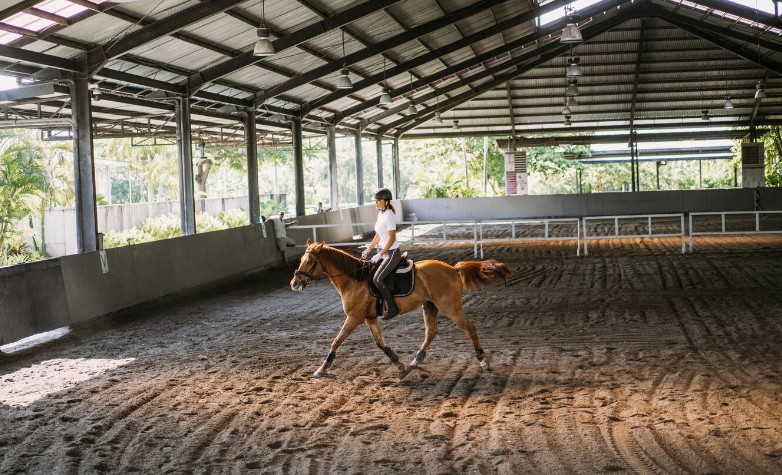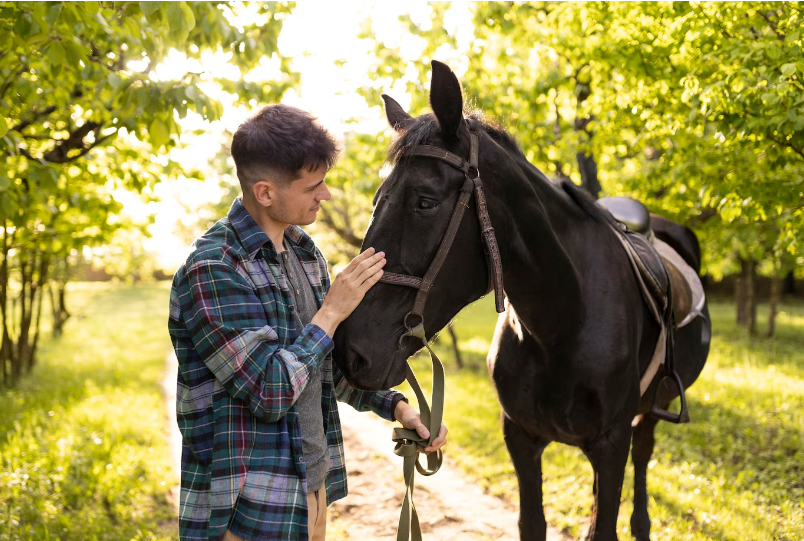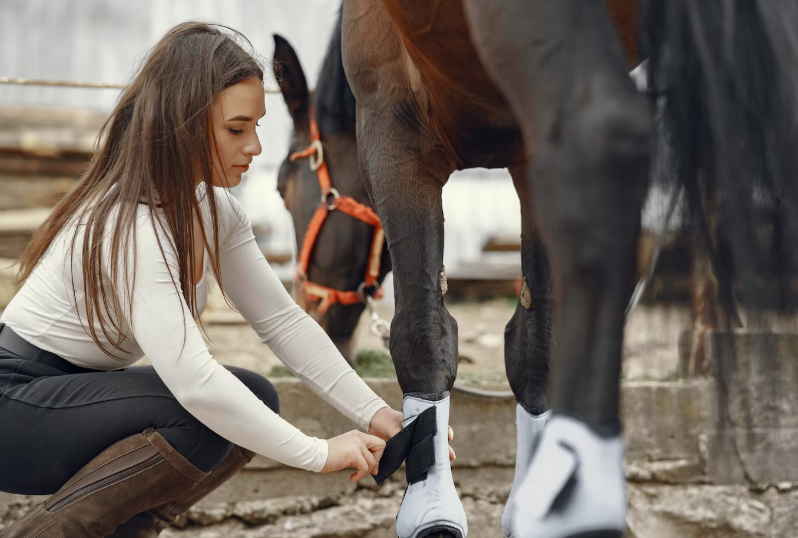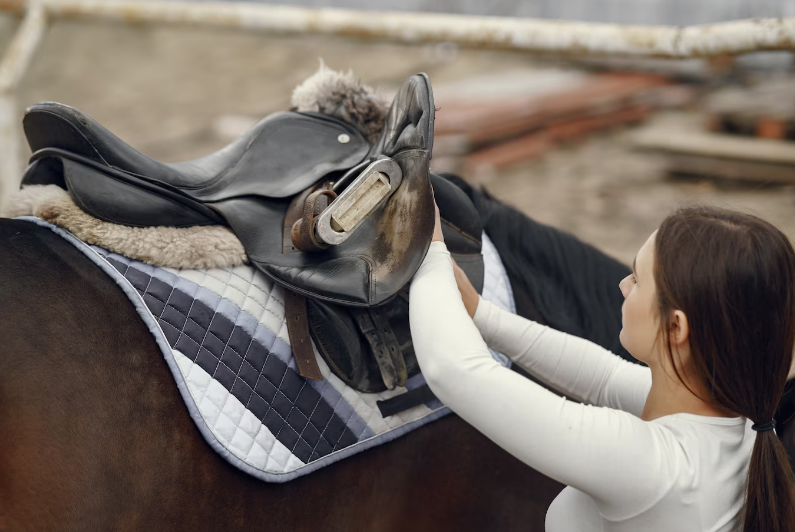Innovative Training Techniques for Sustainable Equine Facilities

Ground exercises for horses to build muscle:
Are you looking to take your equestrian training to the next level? Our innovative training techniques are designed to provide sustainable equine facilities with the tools they need to revolutionize equestrian education. With our ground exercises for horses, you can build muscle and improve overall performance.
Muscle building trot pole exercises:
Our unique muscle building trot pole exercises are designed to enhance strength, flexibility, and coordination for both horse and rider. These exercises are carefully crafted to target specific muscle groups, helping your horse become stronger and more capable.
Experience the difference in equestrian training with our innovative techniques. Join us and revolutionize your equine facility today!
Content:
Advantages of Innovative Training Techniques
When it comes to training horses, traditional methods have long been the norm. However, innovative training techniques have emerged in recent years, offering several advantages over conventional approaches. These techniques, such as muscle building trot pole exercises and ground exercises for horses to build muscle, have revolutionized equestrian education. Here are some of the key advantages of incorporating these innovative training methods:
| 1. Enhanced muscle development:
Innovative training techniques, including muscle building trot pole exercises, focus on targeted muscle development in horses. By incorporating these exercises into training routines, horse owners and trainers can help their equine partners develop stronger and more defined muscles. This can contribute to improved performance and overall athleticism. |
| 2. Injury prevention:
Ground exercises for horses to build muscle not only promote muscle development but also aid in injury prevention. By engaging the horse’s core and promoting stability and balance, these exercises help build a solid foundation for the horse’s body. This, in turn, reduces the risk of injuries during intense physical activities or competitions. |
| 3. Improved coordination and agility:
Innovative training techniques often involve unique exercises and patterns that challenge the horse’s coordination and agility. By incorporating these exercises into training routines, horses can improve their overall coordination and responsiveness to cues. This leads to enhanced performance in various equestrian disciplines. |
| 4. Mental stimulation:
Traditional training methods can sometimes become monotonous for horses, leading to boredom and disengagement. Innovative training techniques introduce exciting and mentally stimulating exercises that keep horses engaged and motivated. This not only enhances the horse’s overall well-being but also contributes to a healthier and happier partnership between horse and rider. |
| 5. Versatility:
Innovative training techniques can be tailored to suit horses of different ages, breeds, and disciplines. Whether the horse is a dressage champion, a seasoned showjumper, or a pleasure trail companion, these techniques can be adapted to meet specific training needs. This versatility allows trainers and horse owners to provide effective and customized training programs for their equine partners. |
By embracing innovative training techniques, horse owners and trainers can unlock new possibilities for their equine partners. These techniques not only promote physical development but also enhance mental stimulation and overall well-being. Investing in equestrian education that incorporates these innovative methods can revolutionize the way horses are trained and ultimately lead to improved performance and success in equestrian pursuits.
Current Challenges in Equestrian Education
Equestrian education plays a vital role in the development and success of riders and trainers in the equine industry. However, there are several challenges that educators and students face when it comes to providing and receiving quality instruction. These challenges include:
Lack of Focus on Muscle Building Trot Pole Exercises
One of the current challenges in equestrian education is the lack of focus on muscle building trot pole exercises. These exercises are crucial for improving a horse’s strength, balance, and coordination. Many equestrian programs tend to prioritize jumping exercises over these fundamental exercises, which can result in an imbalance in a horse’s training program. It is important for educators to emphasize the importance of muscle building trot pole exercises and incorporate them into their curriculum.
Sustainable Equine Facilities
In recent years, the importance of sustainable equine facilities has become a prominent topic in the equestrian industry. Educators face the challenge of teaching students about the importance of environmentally friendly practices and the impact that equine facilities can have on the environment. It is essential for equestrian education programs to include sustainability practices such as proper waste management, energy-efficient design, and the use of renewable resources in their curriculum. By incorporating these practices, the next generation of equestrians will be better equipped to build and manage sustainable equine facilities.
In conclusion, addressing the challenges in equestrian education requires a proactive approach from both educators and students. By focusing on muscle building trot pole exercises and integrating sustainable practices in equine facilities, we can revolutionize equestrian education and ensure a brighter future for the industry.
The Importance of Sustainable Equine Facilities
When it comes to horse training and equestrian education, having a sustainable equine facility is of utmost importance. Sustainable equine facilities not only have a positive impact on the environment but also contribute to the overall well-being and performance of horses.
Ground exercises for horses to build muscle are an essential component of any equine training program. These exercises, such as lunging and long-lining, can be effectively carried out in a well-designed and sustainable facility. The proper footing and layout of the facility allow horses to move freely and perform the necessary exercises without the risk of injury.
In addition to ground exercises, muscle-building trot pole exercises are another valuable training tool in sustainable equine facilities. These exercises involve setting up poles at specific distances and heights, allowing horses to develop and strengthen their muscles through controlled movements. With the right facility infrastructure, including proper footing and a well-designed arena, horses can safely and effectively perform these exercises.
By ensuring the sustainability of equine facilities, we not only provide a safe and conducive environment for horse training but also support the long-term well-being and performance of horses. Sustainable facilities minimize the environmental impact, promote efficient resource utilization, and prioritize the health and safety of both horses and riders.
Investing in innovative training techniques for sustainable equine facilities is an investment in the future of equestrian education. By revolutionizing the way we train and care for horses, we can create a more sustainable and harmonious relationship between horses, humans, and the environment.
Better Efficiency and Resource Management
At Innovative Training Techniques for Sustainable Equine Facilities, we understand the importance of maximizing efficiency and effectively managing resources in equestrian education. Our program focuses on providing ground exercises for horses to build muscle, improve coordination, and enhance overall performance. These exercises are not only beneficial for the horse’s physical development but also help to reduce injuries and improve their well-being.
One of the key exercises we incorporate into our program is the muscle building trot pole exercise. This exercise involves placing a series of poles on the ground at specific intervals to encourage the horse to engage their core muscles and develop balance and coordination. By consistently practicing this exercise, horses can strengthen their muscles and improve their overall performance.
In addition to the muscle building trot pole exercise, we also teach various other ground exercises that focus on different aspects of the horse’s fitness. These exercises are designed to optimize their strength, flexibility, and agility, leading to better efficiency and performance in their equestrian activities.
By implementing these innovative training techniques, equestrian facilities can achieve better efficiency in their operations. Horses become better equipped to handle the physical demands of various disciplines, resulting in improved performance and reduced risk of injuries. With better efficiency, facilities can optimize the use of resources, including time, energy, and equipment.
| Benefits of Better Efficiency and Resource Management: |
|---|
| Reduced risk of horse-related injuries |
| Improved horse performance and athleticism |
| Optimized use of time, energy, and equipment |
| Enhanced overall well-being of horses |
Reducing Environmental Impact
At Innovative Training Techniques for Sustainable Equine Facilities, we understand the importance of minimizing our environmental impact in the equestrian industry. We believe that creating sustainable horse training facilities is not only beneficial for the planet but also for the well-being of our horses.
Ground Exercises for Horses
One of the ways we reduce environmental impact is by utilizing ground exercises for horses to build muscle. These exercises not only provide a great workout for the horses but also eliminate the need for heavy machinery and equipment, which consume fuel and release harmful emissions into the atmosphere.
Ground exercises, such as lunging and long-lining, allow horses to engage their entire bodies and build muscle strength naturally. By focusing on these exercises, we can avoid the use of traditional training methods that rely heavily on riding or driving horses, which can lead to unnecessary strain on their bodies and increase the risk of injuries.
Muscle Building Trot Pole Exercises
Another way we contribute to reducing our environmental impact is through the use of muscle-building trot pole exercises. These exercises involve the placement of poles on the ground in a calculated manner to encourage horses to step over them with a specific gait. By incorporating these exercises into our training programs, we can improve the strength and coordination of our horses without resorting to resource-intensive methods like jumping or galloping.
The use of trot poles not only reduces the wear and tear on horse facilities but also decreases the need for maintenance and repairs. This, in turn, reduces the consumption of natural resources and the production of waste materials associated with conventional horse training activities.
At Innovative Training Techniques for Sustainable Equine Facilities, we are proud to offer an innovative approach to equestrian education that not only enhances the well-being of our horses but also minimizes their environmental impact. Join us on this exciting journey to revolutionize the way we train horses while preserving our planet for future generations.
Revolutionizing Equestrian Education
Equestrian education has never been more advanced with our innovative training techniques and focus on sustainable equine facilities. We are dedicated to improving the welfare of horses and enhancing the skills of equestrians through progressive and effective training methods.
Building Stronger Horses
Our program emphasizes the importance of ground exercises for horses to build muscle and improve overall fitness. Through a series of carefully designed exercises, horses can develop strength, flexibility, and balance, leading to improved performance and reduced risk of injuries.
Achieving Sustainable Equine Facilities
In addition to our training techniques, we also prioritize sustainable equine facilities. We believe in creating environments that minimize the impact on natural resources while providing optimal conditions for horse welfare and performance. Our facilities are designed to promote eco-friendly practices, such as energy-efficient lighting, water conservation, and natural ventilation.
| Benefits of Our Program |
|---|
| 1. Enhanced horse performance |
| 2. Reduced risk of injuries |
| 3. Improved equestrian skills |
| 4. Sustainable facility practices |
| 5. Environmentally friendly approach |
Join us in revolutionizing equestrian education and discover the benefits of our innovative training techniques and commitment to sustainable equine facilities. Together, we can create a brighter future for horses and equestrians alike.
Introducing New Training Methods
As part of our commitment to revolutionizing equestrian education and promoting sustainable equine facilities, we are proud to introduce innovative training methods that will enhance the overall performance and well-being of your equine partners.
One of the key elements of our new training program is the incorporation of muscle building trot pole exercises. These exercises are designed to improve strength, coordination, and muscle development in horses. By strategically placing raised poles on the ground, horses are required to lift their legs higher and engage their core muscles, resulting in enhanced overall muscle tone and power.
In addition to the muscle building trot pole exercises, our new training methods also focus on promoting sustainability in equine facilities. We understand the importance of creating an environment that is not only conducive to optimal horse training but also mindful of environmental impact. By implementing sustainable practices such as using renewable energy sources, reducing waste, and conserving water, we are able to create a training facility that minimizes its carbon footprint and contributes to a greener future for equestrian sports.
With our innovative training techniques for sustainable equine facilities, we aim to provide horse owners and trainers with the tools and knowledge they need to optimize their training practices while promoting responsible and eco-friendly horsemanship. Join us in embracing a new era of equestrian education and experience the transformative benefits these new training methods can bring to your equine partner.
Using Technology to Enhance Learning
Technology plays a crucial role in modern equestrian education, allowing trainers and students to leverage innovative tools to enhance learning. Through the use of various technological advancements, we can now offer a more interactive and engaging training experience.
One such technology that has revolutionized equestrian education is the use of video analysis software. By recording and analyzing riders’ and horses’ movements, trainers can identify areas for improvement and provide personalized feedback. This technology allows students to visually assess their technique, helping them understand how to make adjustments for better performance.
Additionally, the use of virtual reality (VR) and augmented reality (AR) has transformed the way riders learn. Through VR simulations, riders can experience different riding scenarios and challenges in a controlled environment. This allows them to practice and develop their skills without the risk associated with real-life situations. AR technology, on the other hand, can enhance ground exercises for horses to build muscle and improve their overall fitness. Trainers can overlay virtual obstacles and exercises onto the real-world arena, providing horses with a dynamic and engaging workout.
Another technological tool that enhances learning is the integration of wearable devices. These devices, such as smart saddles or sensors, can track and collect data on various aspects of a horse’s movement, such as stride length, speed, and symmetry. This data can then be analyzed to identify areas of improvement and create targeted training plans. By monitoring and quantifying a horse’s progress, trainers and riders can make data-driven decisions to optimize performance and prevent injury.
Lastly, online learning platforms have made education more accessible and flexible than ever before. Through webinars, online courses, and virtual workshops, trainers and students can access educational resources from anywhere in the world. This allows for continuous learning and professional development, even outside of traditional in-person training sessions.
| Benefits of Using Technology in Equestrian Education |
|---|
| 1. Enhanced visual feedback for riders |
| 2. Increased safety through simulated training |
| 3. Improved muscle building through virtual ground exercises for horses |
| 4. Data-driven training plans for optimal performance |
| 5. Accessible and flexible learning opportunities |
Benefits for Equestrian Professionals
Equestrian professionals worldwide can greatly benefit from incorporating innovative training techniques for sustainable equine facilities into their programs. These techniques not only enhance the well-being of horses, but also provide professionals with numerous advantages in their work.
One significant benefit is the ability to rely on ground exercises for horses to build muscle. These exercises focus on strengthening the horse’s core and improving flexibility, leading to enhanced performance in various equestrian disciplines. By integrating these exercises into their training regimen, professionals can help their equine partners develop the physical attributes necessary for success.
Furthermore, the implementation of sustainable equine facilities offers equestrian professionals a competitive edge. As the demand for environmentally friendly practices grows, professionals who can offer sustainable solutions for horse management and training will stand out from their peers. Not only does this demonstrate a commitment to the well-being of horses, but it also aligns with the expectations of environmentally conscious clients and organizations.
Additionally, adopting innovative training techniques for sustainable equine facilities can lead to improved productivity and efficiency in day-to-day operations. Professionals who integrate these techniques into their routines often find that horses become happier and more engaged in their work. This increased enthusiasm translates into better training sessions, faster skill development, and ultimately, more successful performances in competitions or other events.
In conclusion, the benefits of incorporating innovative training techniques for sustainable equine facilities are numerous for equestrian professionals. From building muscle through ground exercises to showcasing commitment to sustainability, professionals can enhance their programs and gain a competitive edge. By prioritizing the well-being of horses and embracing these innovative practices, professionals can revolutionize equestrian education and elevate their own careers in the process.
Improved Skills and Performance
Our innovative training techniques for sustainable equine facilities not only focus on the well-being of horses and the environment but also aim to improve the skills and performance of both riders and horses. Through a variety of ground exercises, horses can develop and strengthen their muscles, leading to enhanced performance in various equestrian disciplines.
Building Muscle through Ground Exercises
Ground exercises play a crucial role in the development of a horse’s muscle strength and overall fitness. Our expert trainers will guide riders in implementing targeted exercises that focus on building muscle and increasing flexibility. These exercises provide a solid foundation for the horse’s physical abilities, leading to improved performance in various riding disciplines.
Muscle Building Trot Pole Exercises
Another effective technique we employ is the use of trot pole exercises. Trot poles are strategically placed on the ground to encourage horses to lift their legs higher and engage their muscles. This type of exercise helps to build muscle strength, improve coordination, and enhance the horse’s balance and stability while trotting.
By incorporating these ground exercises for horses to build muscle and muscle-building trot pole exercises into our training programs, we have witnessed remarkable improvements in the skills and performance of both riders and horses. Our focus on sustainable equine facilities ensures that these techniques are not only effective but also environmentally friendly, allowing for a harmonious partnership between horse and rider.
| Benefits: |
|
|---|
Increased Career Opportunities
By utilizing innovative training techniques for sustainable equine facilities, you can open up a world of increased career opportunities in the equestrian industry.
One area where these techniques can make a significant impact is in the field of horse training. With muscle building trot pole exercises and ground exercises for horses to build muscle, trainers can improve the performance and athleticism of their equine athletes.
Equine therapy is another area that can benefit from these techniques. Trained professionals can use the innovative exercises to help horses recover from injuries and improve their overall well-being. This can lead to increased demand for equine therapists in rehabilitation centers and private practices.
In addition, the growing trend towards sustainable equine facilities presents opportunities for professionals in the fields of architecture and engineering. Designing and constructing eco-friendly barns and arenas requires specialized knowledge and skills.
Furthermore, equestrian education can be revolutionized by incorporating innovative training techniques. This opens up career opportunities for educators and trainers who can create curriculum and teach these techniques to future generations of equestrians.
Overall, by embracing innovative training techniques for sustainable equine facilities, you can position yourself for increased career opportunities in various sectors of the equestrian industry. Whether it’s in horse training, equine therapy, facility design, or equestrian education, the possibilities are endless.
Impact on the Industry
The implementation of innovative training techniques for sustainable equine facilities has revolutionized equestrian education and had a profound impact on the industry. These techniques have not only enhanced the overall welfare and well-being of equine athletes but have also improved the performance and longevity of horses in various disciplines.
One area where these training techniques have made a significant impact is in the development of muscle building trot pole exercises. By incorporating carefully designed trot pole exercises into the training regimen, equine athletes are able to strengthen their muscles and improve their overall balance and coordination.
These exercises involve placing poles on the ground at specific distances and heights, encouraging horses to engage with their hindquarters and develop a more powerful trot. The repetitive nature of these exercises helps to build muscle mass in key areas, such as the hindquarters, back, and abdominal muscles, resulting in improved performance and reduced risk of injury.
Furthermore, the use of sustainable equine facilities has had a positive impact on the environment and the overall sustainability of the equestrian industry. These facilities prioritize eco-friendly practices, such as using renewable energy sources, implementing water-saving measures, and employing proper waste management techniques.
By adopting these sustainable practices, equine facilities can reduce their carbon footprint, minimize resource consumption, and contribute to a cleaner and healthier environment. This not only benefits the industry as a whole but also appeals to environmentally conscious equestrian enthusiasts who prioritize sustainability and animal welfare.
| Benefits of Innovative Training Techniques | Benefits of Sustainable Equine Facilities |
|
|
In conclusion, the implementation of innovative training techniques for sustainable equine facilities, such as muscle building trot pole exercises, has had a significant impact on the equestrian industry. These techniques have not only improved the performance and well-being of equine athletes but also contributed to a more sustainable and eco-friendly industry. By embracing these practices, the industry can continue to evolve and thrive while prioritizing the health of horses and the environment.
Question-Answer:
What is the book “Innovative Training Techniques for Sustainable Equine Facilities” about?
The book “Innovative Training Techniques for Sustainable Equine Facilities” is a comprehensive guide that provides innovative and sustainable training techniques for equestrian facilities. It covers topics such as facility design, horse care, training methods, and environmental sustainability.
Who is the author of “Innovative Training Techniques for Sustainable Equine Facilities”?
The author of “Innovative Training Techniques for Sustainable Equine Facilities” is a renowned equestrian expert, who has years of experience in the field. Their expertise and knowledge in equestrian education make this book a valuable resource for anyone in the industry.
What are some of the innovative training techniques covered in the book?
The book covers a wide range of innovative training techniques for sustainable equine facilities. Some examples include natural horsemanship, positive reinforcement training, and incorporating technology into training methods. These techniques aim to improve horse welfare, enhance communication between horses and riders, and create a sustainable environment for equestrian activities.
How can this book revolutionize equestrian education?
This book can revolutionize equestrian education by introducing new and innovative training techniques that prioritize horse welfare and environmental sustainability. It provides a fresh perspective on traditional training methods and offers practical solutions for creating sustainable equine facilities. By implementing these techniques, equestrian professionals and enthusiasts can enhance the overall well-being of horses and contribute to a more sustainable future for the industry.
Where can I purchase “Innovative Training Techniques for Sustainable Equine Facilities”?
“Innovative Training Techniques for Sustainable Equine Facilities” is available for purchase on various online platforms, such as Amazon and Barnes & Noble. It is also possible to find it in select bookstores specializing in equestrian literature. Additionally, the book may be available for purchase directly from the author’s website.
What is “Innovative Training Techniques for Sustainable Equine Facilities” about?
“Innovative Training Techniques for Sustainable Equine Facilities” is a book that revolutionizes equestrian education by providing innovative training techniques specifically designed for sustainable equine facilities. It offers a comprehensive guide for professionals and horse enthusiasts who are looking to improve their training methods and create environmentally-friendly equine facilities.
Who is the target audience for this book?
The target audience for “Innovative Training Techniques for Sustainable Equine Facilities” includes professionals working in the equestrian industry, such as trainers, facility managers, and equine educators, as well as horse enthusiasts who are interested in improving their training methods and creating sustainable equine facilities. It is suitable for both experienced individuals and those who are new to the field.


